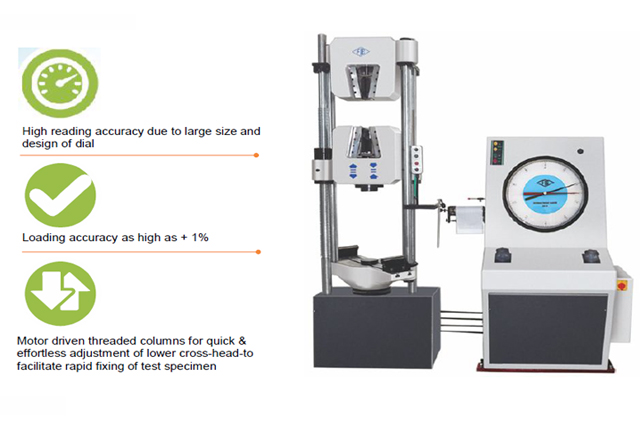- Open type cross head Hydraulic wedge action grips Long test stroke and test space
- Loading accuracy as high as + 1%
- Suitable at variable speeds to suit a wide range of materials.
- Continuous roll autographic recorder supplied as standard to enable study of the behavior of materials.
- Motor driven threaded columns for quick effortless adjustment of lower cross-head-to facilitate rapid fixing of test specimen.
- High reading accuracy due to large size and design of dial.
- Wide range of standard and special accessories, including load stabilizer.
- Easy change from plain to threaded and screwed specimens.
- Large effective clearance between columns enables testing of standards specimens as well as structures.
- Simple controls for ease of operation.
- Robust straining frame of an extremely rigid construction. Safe operation ensured by means of safety devices.
- Fully enclosed and protected pendulum.
- Load Capacity: 100kN, 200kN, 400kN, 600kN & 1000kN.
We are Supplier, Services Provider of Analouge Hydraulic Grip Front Loading Universal Testing Machines and our set up is in Pune, Maharashtra, India
Application :
'FIE' Electronic Universal Testing Machine is designed for testing materials and other materials under tension,
compression bending, transverse and shear loads. Hardness test on metals can also conducted.
Straining unit :
This consists of a cylinder motor with chain and sprocket drive and a table coupled with the ram of the hydraulic cylinder, mounted on to a robust base.
The cylinder and the ram are individually lapped to eliminate friction.
The upper cross-head is rigidly fixed to the table by two strengthened columns.
The lower cross-head is connected to two screwed columns
which are driven by a motor. Axial loading of the ram is
ensured by relieving the cylinder and ram of any possible
side loading by the provision of ball seating.
An displacement scale, with a minimum graduation of 1mm,
is provided to measure the deformation of the specimen.
Tension test is conducted by gripping the test specimen
between the upper and lower cross-heads.
Compression, transverse, bending, shear and hardness
tests are conducted between the lower cross-head and the
table.
The lower cross-head can be raised or lowered rapidly by
operating the screwed columns, thus facilitating ease of
fixing of the test specimen.
Typical HGFL design includes a basic universal testing
machine frame with open type crossheads and hydraulic
wedge action grips.
Control Panel:
The Control Panel consists of a power pack complete with
drive motor and an oil tank, control valves and electronic
display unit.
Power Pack:
The power pack generates the maximum pressure of 200
kgf/cm2. The hydraulic pump provides continuously nonpulsating
oil flow. Hence the load application is very smooth.
Accuracy and Calibration:
FIE Electronic Universal testing machine is closely controlled
for sensitivity, accuracy and calibration during every stage of
manufacture. Machine is calibrated over each of its measuring
range in accordance
with the procedure laid down in British standards 1610: Part1:
1992 and IS 1828: Part1: 1991
FIE Electronic Universal Testing Machine complies with
Grade “A” of BS: 1610:Part1:1992 and class 1 of IS-1828-
Part1:1991.
Pendulum Dynamometer:
This unit permits selection of favorable hydraulic ratios producing relatively small frictional forces.
Pressurized oil in the loading cylinder pushes up the measuring piston proportionately and actuates the special
dynamometer system.
The piston is constantly rotated to eliminate friction.
The dynamometer system is also provided with an integral damper and ensures high reliability of operation.
The load transmitted to the dynamometer is transferred through a pendulum to the load indicator.
Hydraulic Controls:
Hand operated wheels are used to control the flow to and from
the hydraulic cylinder.
The regulation of the oil flow is infinitely variable. Incorporated
in the hydraulic system is a regulating valve, which maintains
a practically constant rate of piston movement.
Control by this valve allows extensometer reading to be taken.
Another Power pack is used to operate wedge action grips by
means of hydraulic cylinder by using solenoid valve operation
For Hydraulic Wedge action grips separate control remote is
provided with selector switches indicating clamp – declamp
and null positions.
Principle of operation for-
Model: UTN-HGFL:
Operation of machine is by hydraulic transmission of load from the test specimen to a separately housed load indicator.
The hydraulic system is ideal since it replaces transmission of load through levers and knife edges, which are prone to wear and damage due to shock on rupture of test pieces.
Load is applied by a historically lubricated ram. Main cylinder pressure is transmitted to the cylinder of the pendulum dynamometer system housed in the control panel.
The cylinder of the dynamometer is also of self-lubricating
design.
The load transmitted to the cylinder of the dynamometer is
transferred through a lever system to a pendulum.
Displacement of the pendulum actuates the rack and pinion
mechanism which operates the load indicator pointer and the
autographic recorder.
The deflection of the pendulum represents the absolute load
applied on the test specimen.
Return movement of the pendulum is effectively damped to
absorb energy in the event of sudden breakage of a
specimen.
Load indicator System (Analogue):
This system consists of a large dial and a pointer.
A dummy pointer is provided to register the maximum load
reached during the test.
Different measuring ranges can be selected by operating the
range selection knob.
An overload trip switch is incorporated which, automatically cuts
out the pump motor when the load range in use is exceeded.
Displacement :
An elongation scale, with a minimum graduation of 1mm, is
provided to measure the deformation of the specimen.
Technical Specifications for - Universal Testing Machine Series - UTN, UTN-HGFL

Colour scheme subject to confirm at the time of order.


